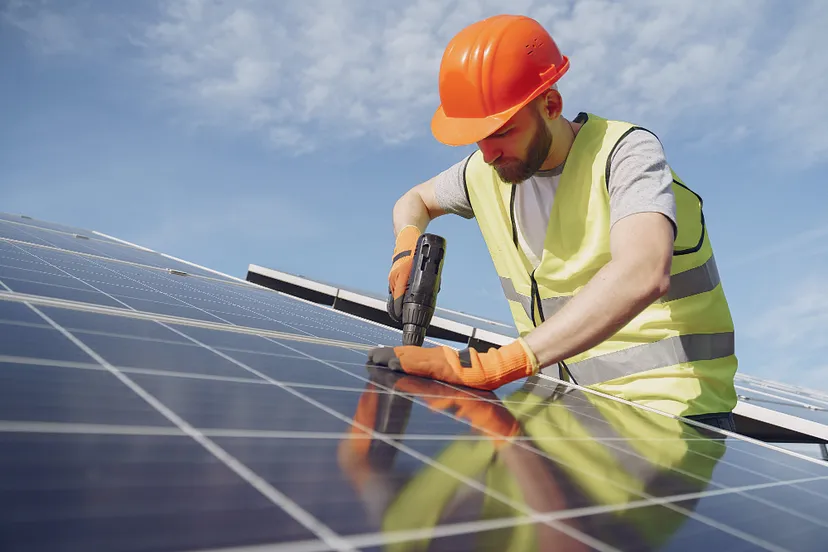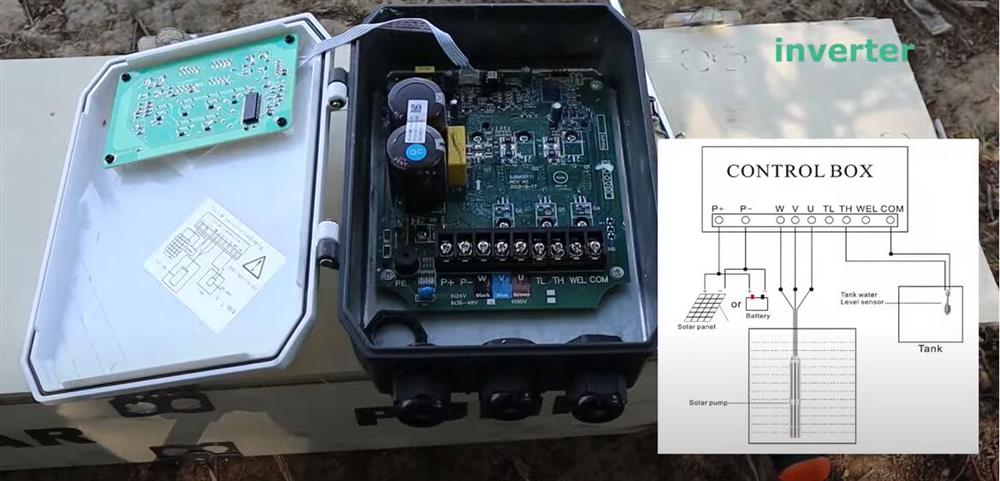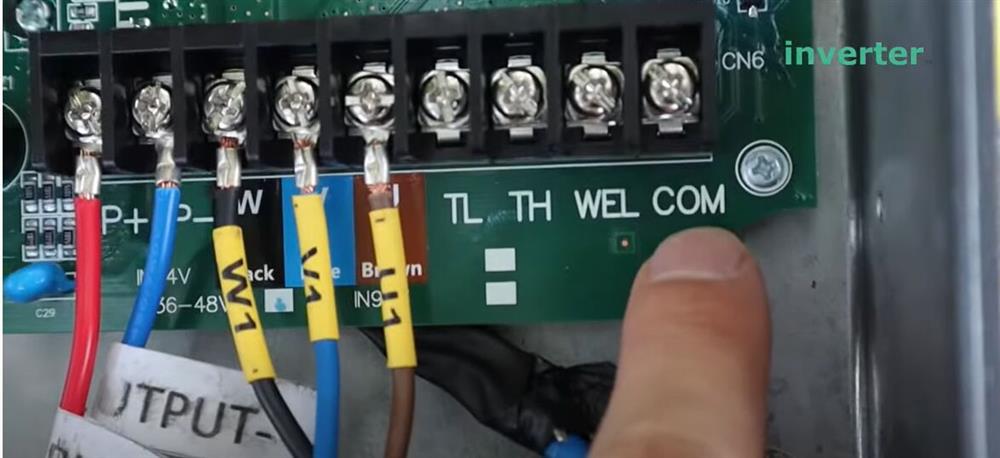
INSTALLATION OF HYBRID INVERTER DEYE – PAGE 1
Applicable for models SUN-5K/6K/8K/10K/12K-SG04LP3-EU
About This Manual
The manual mainly describes the product information, guidelines for installation, operation and maintenance. The manual cannot include complete information about the photovoltaic (PV) system.
How to Use This Manual
Read the manual and other related documents before performing any operation on the inverter. Documents must be stored carefully and be available at all times.
Contents may be periodically updated or revised due to product development. The information in this manual is subject to change without notice. The latest manual can be acquired
1. Safety Introductions
This chapter contains important safety and operating instructions. Read and keep this manual
for future reference.
- Before using the inverter, please read the instructions and warning signs of the battery and the corresponding sections in the instruction manual.
- Do not disassemble the inverter. If you need maintenance or repair, take it to a professional service center.
- Improper reassembly may result in electric shock or fire.
- To reduce the risk of electric shock, disconnect all wires before attempting any maintenance or cleaning. Turning off the unit will not reduce this risk.
- Caution: Only qualified personnel can install this device with a battery.
- Never charge a frozen battery.
- For optimum operation of this inverter, please follow the required specification to select the appropriate cable size. It is very important to correctly operate this inverter.
- Be very cautious when working with metal tools on or around batteries. Dropping a tool may cause a spark or short circuit in batteries or other electrical parts, even causing an explosion.
- Please strictly follow the installation procedure when you want to disconnect AC or DC terminals.
- Please refer to the “Installation” section of this manual for the details.
- Grounding instructions – this inverter should be connected to a permanent grounded wiring system. Be sure to comply with local requirements and regulations to install this inverter.
- Never cause AC output and DC input to short-circuit. Do not connect to the mains when DC input short circuits.
2. Product Introduction
This is a multifunctional inverter, combining the functions of an inverter, solar charger and battery charger to offer uninterruptible power support with a portable size. Its comprehensive LCD display offers user-configurable and easily accessible button operations such as battery charging, AC/solar charging, and acceptable input voltage based on different applications.
2.1. Product Overview
2.2. Product Size

2.3. Product Features
- 230V/4OOV Three phase Pure sine wave inverter.
- Self-consumption and feed-in to the grid.
- Auto restart while AC is recovering.
- Programmable supply priority for battery or grid.
- Programmable multiple operation modes: On grid, off grid and UPS.
- Configurable battery charging current/voltage based on applications by LCD setting.
- Configurable AC/Solar/Generator Charger priority by LCD setting.
- Compatible with mains voltage or generator power.
- Overload/over temperature/short circuit protection.
- Smart battery charger design for optimized battery performance
- With limit function, prevent excess power overflow to the grid.
- Supporting WIFI monitoring and build-in 2 strings for 1 MPP tracker, 1 string for 1 MPP tracker.
- Smart settable three stages MPPT charging for optimized battery performance.
- Time of use function.
- Smart Load Function.
2.4. Basic System Architecture
The following illustration shows the basic application of this inverter.
It also includes the following devices to have a Complete running system.
– Generator or Utility
– PV modules
Consult with your system integrator for other possible system architectures depending on your requirements.
This inverter can power all kinds of appliances in a home or office environment, including motor-type appliances such as refrigerators and air conditioners.

3. Installation
3.1. Parts List (12)
3.2. Mounting instructions
Installation Precaution
This Hybrid inverter is designed for outdoor use(lP65), Please make sure the installation site meets the below conditions:
- Not in direct sunlight
- Not in areas where highly flammable materials are stored.
- Not in potentially explosive areas.
- Not in the cool air directly.
- Not near the television Antenna or antenna cable.
- Not higher than the altitude of about 2000 meters above sea level.
- Not in an environment of precipitation or humidity (>95%)
Please AVOID direct sunlight, rain exposure, and snow laying up during installation and operation. Before connecting all wires, please take off the metal cover by removing
the screws as shown below:

Considering the following points before selecting where to install:
- Please select a vertical wall with load-bearing capacity for installation, suitable for installation on concrete or other non-flammable surfaces, installation is shown below.
- Install this inverter at eye level in order to allow the LCD display to be read at all times.
- The ambient temperature is recommended to be between -40~60“C to ensure optimal operation.
- Be sure to keep other objects and surfaces as shown in the diagram to guarantee sufficient heat dissipation and have enough space for removing wires.

For proper air circulation to dissipate heat, allow a clearance of approx. 50cm to the side and approx. 50cm above and below the unit. And 100cm to the front.
Mounting the inverter
Remember that this inverter is heavy! Please be careful when lifting out from the package. Choose the recommended drill head (as shown below pic) to drill 4 holes on the wall, 82-90mm deep.
- Use a proper hammer to fit the expansion bolt into the holes.
- Carry the inverter and hold it, make sure the hanger aims at the expansion bolt, and fix the inverter on the wall.
- Fasten the screw head of the expansion bolt to finish the mounting.
3.3 Battery connection
For safe operation and compliance, a separate DC over-current protector or disconnect device is required between the battery and the inverter. In some applications, switching devices may not be required but over-current protectors are still required. Refer to the typical amperage in the table below for the required fuse or circuit breaker size.
| Model | Wire Size | Cablel (mm2) | Torque value (max) |
|---|---|---|---|
| 5 Kw | 2 AWG | 35 | 24.5 Nm |
| 6/8 Kw | 1 AWG | 50 | 24.5 Nm |
| 10/12 Kw | 1/0 AWG | 50 | 24.5 Nm |
Please follow the below steps to implement battery connection:
- Please choose a suitable battery cable with the correct connector which can well fit into the battery terminals.
- Use a suitable screwdriver to unscrew the bolts and fit the battery connectors in, then fasten the bolt by the screwdriver, making sure the bolts are tightened with a torque of 24.5 N.M in a clockwise direction.
- Make sure the polarity at both the battery and inverter is correctly connected.
- In case of children touch or insects go into the inverter, Please make sure the inverter connector is fastened to a waterproof position by twisting it clockwise.
3.3.2 Function port definition

A
CN1:
- TEMP (1,2): battery temperature sensor for the lead acid battery.
- CT-L1 (3,4): current transformer (CT1) for “zero export to CT” mode clamps on L1 when in a three-phase system.
- CT-L2 (5,6): current transformer (CT2) for “zero export to CT” mode clamps on L2 when in a three-phase system.
- CT-L3 (7,8): current transformer (CT3) for “zero export to CT” mode clamps on L3 when in a three-phase system.
CN2:
- G-start (1,2): dry contact signal for the startup of the diesel generator. When the “GEN signal” is active, the open contact (GS) will switch on (no voltage output).
- G-valve (3,4): Dry contact output. When the inverter is in off-grid mode and the ”signal island mode” is checked, the dry contact will switch on.
- Grid_Ry (5,6): reserved.
- RSD (7,8): When the battery is connected and the inverter is in “ON” status, it will provide 12Vdc.

B
- Parallel A: Parallel communication port 1 (CAN interface)
- Parallel B: Parallel communication port 2 (CAN interface)
- Meter_485: for energy meter communication.
- ModeBUS: Reserved.
- BMS: BMS port for battery communication(CAN/RS48).
3.3.3 Temperature sensor connection for lead-acid battery

3.4 Grid connection and backup load connection
- Before connecting to the grid, please install a separate AC breaker between the inverter and the grid. Also, it is recommended that installs an AC breaker between the backup load and inverter. This will ensure the inverter can be securely disconnected during maintenance and fully protected from overcurrent. The recommended of AC breaker for the load port is 20A for 8kw, 32A for 10kw, and 32A for 12KW. The recommended of AC breaker for the grid port is 63A for 8kw, 63A for 10kw, and 63A for 12KW.
- There are three terminal blocks with “Grid” “Load” and “GEN” markings. Please do not misconnect in ut and output connectors.
| Model | Wire Size | Cablel (mm2) | Torque value (max) |
|---|---|---|---|
| 5/6/8/12 Kw | 10 AWG | 4 | 1.2 Nm |
| Model | Wire Size | Cablel (mm2) | Torque value (max) |
|---|---|---|---|
| 5/6/8/12 Kw | 10 AWG | 6 | 1.2 Nm |
Please follow the below steps to implement Grid, load and Gen port connection:
- Before making the Grid, load and Gen port connection, be sure to turn off the AC breaker or disconnector first.
- Remove the insulation sleeve 10 mm in length, unscrew the bolts, insert the wires according to the polarities indicated on the terminal block, and tighten the terminal screws. Make sure the connection is complete.

- Then, insert AC output wires according to the polarities indicated on the terminal block and tighten the terminal. Be sure to connect corresponding N wires and PE wires to related terminals as well.
- Make sure the wires are securely connected.
- Appliances such as air conditioner are required at least 2-3 minutes to restart because it is
- required to have enough time to balance refrigerant gas inside the circuit. If a power shortage occurs and recovers in a short time, it will cause damage to your connected appliances. To prevent this kind of damage, please check with the manufacturer of the air conditioner if it is equipped with a time-delay function before installation. Otherwise, this inverter will trigger an overload fault and cut off output to protect your appliance but sometimes it still causes internal damage to the air conditioner.
3.5 PV Connection
Before connecting to PV modules, please install a separate DC circuit breaker between the inverter and PV modules. It is very important for system safety and efficient operation to use appropriate cable for PV module connection. To reduce the risk of injury, please use the proper recommended cable size as below.
| Model | Wire Size | Cablel (mm2) |
|---|---|---|
| 5/6/8/12 Kw | 12 AWG | 4 |
3.5.1 PV Module Selection:
When selecting proper PV modules, please be sure to consider below parameters:
- Open circuit Voltage (Voc) of PV modules does not exceed the max. PV array open circuit voltage of the inverter.
- Open circuit Voltage (Voc) of PV modules should be higher than min. start voltage.
- The PV modules used to connect to this inverter shall be Class A rating certified according to IEC 61730.
| Inverter Model | 5 Kw | 6 Kw | 8 Kw | 10 Kw | 12 Kw |
|---|---|---|---|---|---|
| PV Input Voltage | 550V (160V ~ 800V) | 550V (160V ~ 800V) | 550V (160V ~ 800V) | 550V (160V ~ 800V) | 550V (160V ~ 800V) |
| PV Array MPPT Voltage Range | 200V ~ 650V | 200V ~ 650V | 200V ~ 650V | 200V ~ 650V | 200V ~ 650V |
| No. of MPP Trackers | 2 | 2 | 2 | 2 | 2 |
| No. of Strings per MPP Tracker | 1+1 | 1+1 | 1+1 | 2+1 | 2+1 |
3.5.2 PV Module Wire Connection:
- Switch the Grid Supply Main Switch(AC)OFF.
- Switch the DC isolator OFF.
- Assemble the PV input connector to the inverter.


| Cable type | Cross section (mmz) | |
|---|---|---|
| Industry generic PV cable 4.0”6.0 (model: PV1-F) | Range | Recommended value |
| 4.0”6.0 (12~10AWG) |
4.0 (12AWG) | |
Chart 3-6The steps to assemble the DC connectors are listed as follows:
a) Strip off the DC wire about 7mm, and disassemble the connector cap nut (see picture 5.3)

b) Crimping metal terminals with crimping pliers as shown in picture 5.4.

c) Insert the contact pin to the top part of the connector and screw up the cap nut to the top part of the connector. (as shown in picture 5.5)

d) Finally insert the DC connector into the positive and negative input of the inverter, like shown in picture 5.6

3.6 CT Connection

*Note: when the reading of the load power on the LCD is not correct, please reverse the CT arrow.
3.6.1 Meter Connection


3.7 Earth Connection (mandatory)
Ground cable shall be connected to the ground plate on the grid side this prevents electric shock if the original protective conductor fails.

3.8 WIFI Connection
For the configuration of the Wi-Fi Plug, please refer to the illustrations of the Wi-Fi Plug. The Wi-Fi Plug is not a standard configuration, it’s optional.
3.9 Wiring System for Inverter
This diagram is an example of an application that neutral connects with the PE in a distribution box.
For countries such as Australia, New Zealand, South Africa, etc., please follow local wiring regulations!

3.10 Wiring diagram
This diagram is an example of an application in which neutral is separated from the PE in the distribution box/ For countries such as China, Germany, the Czech Republic, Italy, etc., please follow local wiring regulations!
Note: The backup function is optional in the German market. Please leave the backup side empty if the backup function is not available in the inverter.


1) DC Breaker for battery
SUN 5K—SG—EU: 150A DC breaker
SUN 6K—SG—EU: 200A DC breaker Backup Load
SUN 8K—SG—EU: 250A DC breaker
SUN 10K—SG—EU: 300A DC breaker
SUN 12K—SG—EU: 300A DC breaker
2) AC Breaker for backup load
SUN SK—SG—EU: 16A AC breaker
SUN 6K—SG—EU: 16A AC breaker
SUN 8K—SG—EU: 20A AC breaker
SUN 10K—SG—EU: 32A AC breaker
SUN 12K—SG—EU: 32A AC breaker
3) AC Breaker for grid
SUN 5K—SG—EU: 63A AC breaker
SUN 6K—SG—EU: 63A AC breaker
SUN 8K—SG—EU: 63A AC breaker
SUN 10K—SG—EU: 63A AC breaker
SUN 12K—SG—EU: 63A AC breaker
4) AC Breaker for home load
Depends on the household loads
3.11 Typical application diagram of diesel generator
Max. 10pcs parallel for on-grid and off-grid operation.

4. OPERATION
4.1 Power ON/OFF
Once the unit has been properly installed and the batteries are connected well, simply press the On/Off button (located on the left side of the case) to turn on the unit. When the system is without a battery connected, but connected with either PV or grid, and the ON/OFF button is switched off, LCD will still light up (Display will show OFF), In this condition, when switching on the ON/OFF button and selecting NO battery, the system can still work.
4.2 Operation and Display Panel
The operation and display panel, shown in the below chart, is on the front panel of the inverter. It includes four indicators, four function keys, and an LCD display, indicating the operating status and input/output power information.
| LED Indicator | Messages | |
|---|---|---|
| DC | Green-led solid light | PV Connection normal |
| AC | Green-led solid light | Grid Connection normal |
| Normal | Green-led solid light | Inverter operating normally |
| Alarm | Red-led solid light | Malfunction or warning |
| Function Key | Description |
|---|---|
| Esc | To exit the setting mode |
| Up | To go to the previous selection |
| Down | To go to the next selection |
| Enter | To confirm the selection |





















